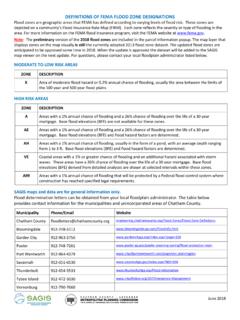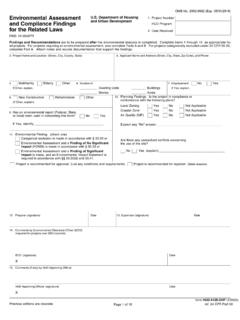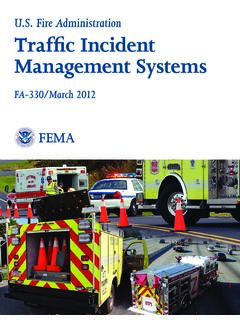Transcription of Introduction to the National Flood Insurance …
1 Introduction to the National Flood Insurance Program (NFIP). Diane P. Horn Analyst in Flood Insurance and Emergency Management Jared T. Brown Analyst in Emergency Management and Homeland Security Policy April 30, 2018. Congressional Research Service 7-5700. R44593. Introduction to the National Flood Insurance Program (NFIP). Summary The NFIP was established by the National Flood Insurance Act of 1968 (NFIA, 42 4001. et seq.), and was most recently reauthorized to July 31, 2018, through a series of short-term reauthorizations.
2 The general purpose of the NFIP is both to offer primary Flood Insurance to properties with significant Flood risk, and to reduce Flood risk through the adoption of floodplain management standards. Communities volunteer to participate in the NFIP in order to have access to federal Flood Insurance , and in return are required to adopt minimum standards. FEMA manages a process, called Risk MAP, to produce Flood Insurance Rate Maps (FIRMs). Depicted on FIRMs are Special Flood Hazard Areas (SFHAs), which is the area exposed to a 1%.
3 Or greater risk of annual flooding. FIRMs vary in age across the country, and are updated on a prioritized basis. The Risk MAP process provides extensive outreach and appeal opportunities for communities. Updating a community's FIRMs can take three to five years or more. Participating communities must adopt a Flood map and enact minimum floodplain standards to regulate development in the SFHA. FEMA encourages communities to enhance their floodplain standards by offering reduced premium rates through the Community Rating System (CRS).
4 FEMA also manages a Flood Mitigation Assistance (FMA) grant program using NFIP revenues to further reduce comprehensive Flood risk. NFIP Insurance uses one of three types of Standard Flood Insurance Policies (SFIPs). SFIPs have maximum coverage limits set by law. Any federal entity that makes, guarantees, or purchases mortgages must, by law, require property owners in the SFHA to purchase Flood Insurance , generally through the NFIP. In moderate risk areas, community members may purchase Preferred Risk Policies (PRPs) that offer less costly Insurance .
5 The day-to-day sale, servicing, and claims processing of NFIP policies are conducted by private industry partners. Most policies are serviced by companies that are reimbursed through the Write Your Own (WYO) Program. The premium rate for most NFIP policies is intended to reflect the true Flood risk. However, Congress has directed FEMA to subsidize Flood Insurance for properties built before the community's first FIRM ( , the pre-FIRM subsidy). In addition, FEMA grandfathers . properties at their rate from past FIRMs to updated FIRMs through a cross-subsidy.
6 Congress also directed the development of an Affordability Study, and a forthcoming Draft Affordability Framework, to evaluate methods for making Flood Insurance more affordable. Participating communities that fail to adopt FIRMs or maintain minimum floodplain standards can be put on probation or suspended from the NFIP. In communities that do not participate in the NFIP, or have been suspended, individuals cannot purchase NFIP Insurance . Individuals in these communities also face challenges receiving federal disaster assistance in Flood hazard areas, and have difficulties receiving federally backed mortgages.
7 Congress has provided appropriations to the NFIP for some of the cost of Risk MAP. Congress also authorizes the use of premium revenues for other NFIP costs, including administration, salaries, and other expenses. NFIP premiums also include other charges, such as a Federal Policy Fee, a Reserve Fund assessment, and a surcharge to help fund the NFIP. In October 2017, Congress cancelled $16 billion of NFIP debt, making it possible for the program to pay claims for Hurricanes Harvey, Irma, and Maria. The NFIP currently owes $ billion to the Treasury, leaving $ billion in borrowing authority from a $ billion limit in law.
8 This debt is serviced by the NFIP and interest is paid through premium revenues. After July 31, 2018, key authorities of the NFIP, such as the authority to issue new Insurance contracts, will expire if they are not reauthorized by Congress. Congressional Research Service Introduction to the National Flood Insurance Program (NFIP). Contents Introduction .. 1. Purpose of the NFIP .. 2. Reduction of Comprehensive Flood 3. Risk Mapping, Assessment, and Planning (Risk MAP) and Flood Insurance Rate Maps (FIRMs).
9 3. Flood Zones .. 3. Updating Flood Maps .. 4. Map Corrections .. 6. State and Local Land Use Controls .. 6. Flood Mitigation Assistance Grants .. 8. Primary Flood Insurance through the NFIP .. 8. Standard Flood Insurance Policies (SFIPs) .. 8. Mandatory Mortgage Purchase Requirement .. 9. Preferred Risk Policies (PRPs).. 11. Increased Cost of Compliance (ICC) Coverage .. 11. Servicing of Policies and Claims Management .. 12. Pricing and Premium Rate Structure .. 14. Pre-FIRM Subsidy .. 15. Newly Mapped Subsidy.
10 17. Grandfathering Cross-Subsidy .. 17. Community Rating System .. 18. Affordability Study and Framework .. 19. Nonparticipating Communities and Community Suspension .. 20. 21. Premium Fees and Surcharges .. 21. Appropriations and Offsetting Receipts .. 22. Borrowing from the Treasury, NFIP Debt .. 24. NFIP Purchase of Reinsurance .. 25. Expiration of Certain NFIP Authorities .. 26. Tables Table 1. Flood Zones as Depicted on Flood Insurance Rate Maps (FIRMs).. 4. Table 2. Maximum Available Coverage Limits for SFIPs by Occupancy Type.













